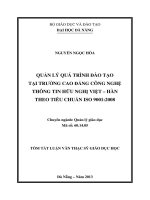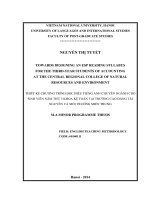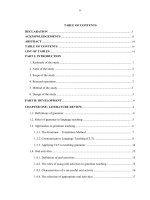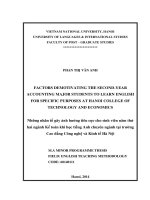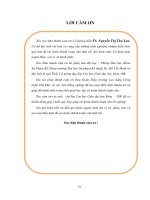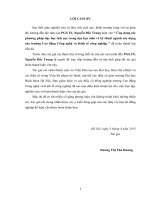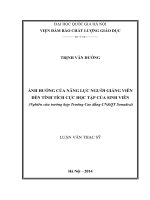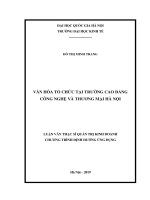Những nhân tố gây ảnh hưởng tiêu cực cho sinh viên năm thứ hai ngành Kế toán khi học tiếng Anh chuyên ngành tại trường Cao đẳng Công nghệ và Kinh tế Hà Nội
Bạn đang xem bản rút gọn của tài liệu. Xem và tải ngay bản đầy đủ của tài liệu tại đây (676.64 KB, 49 trang )
VIETNAM NATIONAL UNIVERSITY, HANOI
UNIVERSITY OF LANGUAGES & INTERNATIONAL STUDIES
FACULTY OF POST – GRADUATE STUDIES
*********************
PHAN THỊ VÂN ANH
FACTORS DEMOTIVATING THE SECOND-YEAR
ACCOUNTING MAJOR STUDENTS TO LEARN ENGLISH
FOR SPECIFIC PURPOSES AT HANOI COLLEGE OF
TECHNOLOGY AND ECONOMICS
Những nhân tố gây ảnh hƣởng tiêu cực cho sinh viên năm thứ
hai ngành Kế toán khi học tiếng Anh chuyên ngành tại trƣờng
Cao đẳng Công nghệ và Kinh tế Hà Nội
M.A MINOR PROGRAMME THESIS
FIELD: ENGLISH TEACHING METHODOLOGY
CODE: 60140111
Hanoi, 2014
VIETNAM NATIONAL UNIVERSITY, HANOI
UNIVERSITY OF LANGUAGES & INTERNATIONAL STUDIES
FACULTY OF POST – GRADUATE STUDIES
*********************
PHAN THỊ VÂN ANH
FACTORS DEMOTIVATING THE SECOND-YEAR
ACCOUNTING MAJOR STUDENTS TO LEARN ENGLISH
FOR SPECIFIC PURPOSES AT HANOI COLLEGE OF
TECHNOLOGY AND ECONOMICS
Những nhân tố gây ảnh hƣởng tiêu cực cho sinh viên năm thứ
hai ngành Kế toán khi học tiếng Anh chuyên ngành tại trƣờng
Cao đẳng Công nghệ và Kinh tế Hà Nội
M.A MINOR PROGRAMME THESIS
FIELD: ENGLISH TEACHING METHODOLOGY
CODE: 60140111
SUPERVISOR: DƢƠNG THỊ NỤ, PhD.
Hanoi, 2014
i
DECLARATION
I hereby certify that the thesis entitled “Factors demotivating the second-year
Accounting major students to learn ESP at Hanoi College of Technology and Economics”
is the result of my own research in the fulfillment of the requirement for the Degree of
Master of University of Languages and International Studies and the thesis has not been
submitted for any degree at any other university or tertiary institution.
Hanoi, August 17
th
, 2014
Signature
Phan Thị Vân Anh
ii
ACKNOWLEDGEMENTS
I would like to send my thanks to all people who have supported me in doing this
minor thesis.
Firstly, I would like to express my deepest gratitude to Dr. Dương Thị Nụ, my
supervisor, for her invaluable guidance and encouragement in the completion of my
research paper.
Secondly, I gratefully acknowledge all the lectures at Faculty of Post-Graduate
Studies, University of Languages and International Studies for providing us with
knowledge from precious and helpful lectures.
Thirdly, I would like to express my sincere thanks to all my colleagues and my
students at Hanoi College of Technology and Economics for providing support and
assistance in completing my minor thesis.
Last but not least, my hearted thanks go to my family and my friends for their
enormous spiritual support.
Hanoi, August 2014.
iii
ABSTRACT
For recent years, English for Specific Purposes (ESP) has been an important area in
English language teaching and learning. However, there has been very little research
reported on demotivation of students in the course of learning ESP, especially in learning
English for Accounting. The aim of this study was therefore to investigate factors
demotivating the second-year Accounting major students to learn ESP at Hanoi College of
Technology and Economics (HCTE). A survey questionnaire was carried out by 97
Accounting major students at HCTE. Furthermore, in order to back up the validity of the
collected data from the questionnaire, semi-structured interviews were conducted with 10
randomly selected students who had already done the survey questionnaire. Other semi-
structured interviews were also conducted with four teachers who were teaching ESP at
HCTE at that time. The findings of the study revealed four demotivating factors including:
students’ lack of self-confidence due to their experience of failure and lack of specialized
background knowledge, teachers’ behaviors, competence and teaching methods,
considered as a strongly demotivating factor, the course book and teaching facilities. Based
on the findings, some solutions were provided to help students to overcome their
demotivation in learning ESP. It is hoped that the results of this study will be helpful to
improve ESP teaching and learning at HCTE.
iv
TABLE OF CONTENTS
Declaration i
Acknowledgements ii
Abstract iii
Table of contents iv
List of abbreviations vi
List of tables vii
PART A: INTRODUCTION 1
1. Rationale 1
2. Aims of the study 1
3. Research questions 1
4. Scope of the study 2
5. Methods of the study 2
6. Design of the study 2
PART B: DEVELOPMENT 3
CHAPTER 1: LITERATURE REVIEW 3
1.1. Conceptions of motivation 3
1.2. Conceptions of demotivation 3
1.3. Factors affecting students’ demotivation 4
1.4. Related issues of ESP 6
1.4.1. The definition of ESP 6
1.4.2. Classification of ESP 7
1.4.3. ESP teachers 8
1.4.4. ESP learners 10
1.4.5. ESP materials 11
1.5. Previous studies on demotivation in the world and in Vietnam 12
CHAPTER 2: RESEARCH METHODOLOGY 14
2.1. Research questions 14
2.2. Situation analysis 14
2.2.1. Setting of the study 14
2.2.2. Participants of the study 15
2.3. Data Collection 16
v
2.3.1. Questionnaire for students 16
2.3.2. Interviews for students 16
2.3.3. Interviews for teachers 16
2.4. Data analysis 17
CHAPTER 3: RESULTS AND DISCUSSIONS 18
3.1. Results 18
3.1.1. Data analysis of students’ survey questionnaire and interviews 18
3.1.1.1. Personal information of the students taking part in the survey 18
3.1.1.2. Student-related demotivating factors 18
3.1.1.3. Teacher-related demotivating factors 20
3.1.1.4. The course book 22
3.1.1.5. Teaching and learning conditions 23
3.1.1.6. Solutions suggested by the students 23
3.1.2. Data analysis of teacher interviews 24
3.2. Major findings and discussion 26
3.3. Pedagogical implications 27
3.3.1. Improving ESP teachers’ specialized knowledge 27
3.3.2. Improving ESP teachers’ behaviors and teaching methods 27
3.3.3. Helping students to enrich their background knowledge 28
3.3.4. Adapting the current course book 28
3.3.5. Improving the facilities and learning conditions 28
PART C: CONCLUSION 30
1. Conclusions 30
2. Limitations of the study 31
3. Suggestions for further study 31
REFERENCES 32
APPENDIX 1 I
APPENDIX 2 III
APPENDIX 3 V
APPENDIX 4 VI
vi
LIST OF ABBREVIATIONS
ESP: English for specific Purposes
ELT: English Language Teaching
EAP: English for Academic Purposes
EOP: English for Occupational Purposes
GE: General English
HCTE: Hanoi College of Technology and Economics
vii
LIST OF TABLES
Table 1: Students’ profiles (Total number of the students: 97) 18
Table 2: Student-related demotivating factors 19
Table 3: Teacher-related demotivating factors 20
Table 4: The course book 22
Table 5: Teaching and learning conditions 23
1
PART A: INTRODUCTION
The first part of this thesis is to introduce the rationale, the aims of the study as well
as the research questions which the study was to carry out to find out the answers. It also
presents the significance of the study, the scope of the study, an overview of the methods
employed to conduct the research, as well as its design.
1. Rationale
English for Specific Purposes (ESP) is an important area in English language
teaching and learning today. ESP is also a compulsory subject for students who passed
General English (GE) courses at Hanoi College of Technology and Economics (HCTE).
Moreover, having a good knowledge of GE and especially ESP is considered to be
necessary means for any graduates to get better jobs.
However, after teaching ESP for several years, especially English for Accounting, I
have come to realize that most of the students in HCTE meet the difficulties in learning
ESP. They seem to lack motivation in learning ESP. Moreover, motivation is considered to
be one of the most important elements in language learning. There are a variety of factors
affecting students’ motivation. Among these factors are their learning purposes,
instructional content or teaching methods…
Up to now, many researchers have examined motivation and demotivation in
learning GE. However, there has been very little research reported on demotivation of
students in the course of learning ESP. Therefore, the purpose of this study is to ascertain
factors that demotivated the second-year Accounting major students to learn ESP at HCTE.
I do hope that the results of the study can help students to overcome their demotivation in
learning ESP and help teachers to improve the effectiveness of teaching ESP at HCTE.
2. Aims of the study
With the above rationale, the study was conducted with the following aims:
- To identify factors demotivating the second-year accounting major students to
learn ESP at HCTE.
- To recommend some suggestions for teachers and students at HCTE to get better
ESP teaching – learning.
3. Research questions
In order to achieve the above-mentioned aims, the following research questions
were asked in the study:
2
Question 1: What are the factors that demotivate the second-year accounting major
students to learn ESP at HCTE?
Question 2: What solutions can be offered to minimize these factors and help
students at HCTE to overcome their demotivation?
4. Scope of the study
The scope of the study is to find out factors that demotivate the second-year
Accounting major students in learning ESP at HCTE. It involves the participation of 4
teachers of English and 97 second-year accounting major students at HCTE who have just
finished ESP. To go ahead, it also offers some suggestions to better the current context.
5. Methods of the study
To achieve the aims of the study, the study used both qualitative and quantitative
methods for data collection and analysis. The data were collected by means of the survey
questionnaire and the interviews. The questionnaire for students and the semi-structured
interviews were used to get students’ opinions on their demotivation factors in learning
ESP. The semi-structured interviews for teachers were also used to find out their ideas
about factors demotivating their students in ESP classes. All comments, findings and
suggestions given in the thesis were based on the analysis of the data.
6. Design of the study
The study includes three parts.
Part A, INTRODUCTION, presents the rationale, aim of the study, scope of the
study, methods of the study and design of the study.
Part B, DEVELOPMENT, consists of three main chapters:
Chapter 1, LITERATURE REVIEW, provides conceptions of motivation and
demotivation in language learning. The main issues related to ESP are also presented in
this chapter.
Chapter 2, RESEARCH METHODOLOGY, presents the methodology used in the
study.
Chapter 3, RESULTS AND DISCUSSIONS, provides a detailed presentation of
data and detailed description of data analysis. The implications of the study are also given
in this chapter.
Part C, CONCLUSION, is a review of the study. Furthermore, this part also points
out the limitations of the study and provides some suggestions for further studies.
3
PART B: DEVELOPMENT
CHAPTER 1: LITERATURE REVIEW
This chapter will briefly present a theoretical background of the study with the
examination of the concepts most relevant to the thesis’s topic. It consists of the concepts
of motivation and demotivation as well as factors affecting students’ demotivation. Besides,
the overall of ESP will be discussed.
1. 1. Conceptions of motivation
There have been a number of motivation concepts by different authors. It is
strongly believed that motivation plays a significant role in academic learning in general
and the second language learning in particular. Motivational factors or motives have been
considered as kinds or inducements with the effect of energizing ongoing action (Dӧrnyei,
2001).
Keller (1984) assumed that “interest” is one of the main apparatus of motivation in
foreign and second language learning. Meanwhile Gardner (1985) considered the
importance of efforts and desires to obtain the learning goal “Motivation in the present
context refers to the combination of effort plus desire to achieve the goal of learning plus
favorable attitudes towards learning the language” (p. 10).
However, Littlewood (1998) found that motivation is complexly combined by
different components including “the individual’s driver, need for achievement and success,
curiosity, desire for stimulation and new experience, and so on” and “motivation is both
intrinsically and extrinsically-originated”(p.53)
In short, it can be deduced that motivation is the way learners set up goals and
spend effort to pursue them.
1.2. Conceptions of demotivation
Traditionally, motivation has been considered as a many-sided construct consisting
of various positive influences. However, there is another aspect of motivation left without
being properly attended, it is demotivation.
Dӧrnyei (2001) suggested that demotivation concerns “specific external forces that
reduce or diminish the motivational basis of a behavioral intention or an ongoing action”.
These negative external factors consist of items such as the class environment, teaching
situations, methods, teachers’ behaviors and so on. In addition, in his study, Dӧrnyei (2001,
p.143) also identifies the three negative factors that cannot be considered as instances of
4
demotivation: powerful distraction, continuing loss of interest in a long-lasting, ongoing
activity, and the sudden recognitions of the costs of an activity.
Furthermore, Dӧrnyei (2001) made a distinction between demotivation and
amotivation. The term amotivation was first used by Deci and Ryan (1985). According to
them, amotivation refers to lack of motivation and an amotivation learner is someone who
thinks “there is no point in me pursuing this”. Dӧrnyei (2001) stated that demotivation
does not mean that a learner has lost his or her motivation completely while an amotivation
learner has lost his or her motivation totally. The difference between the two related
terminations is that when an amotivated learner is someone who has found the general
outcome expectations to be unrealistic for one reason or another, a demotivated learner is
someone whose motivation has decreased due to some external factors. In the course of
time, demotivation can develop into amotivation (Dӧrnyei, 2001), that is, a series of
demotivating experiences can lead to a complete loss of motivation.
In brief, a demotivating factor is some external force that reduces or decreases the
learner’s motivation. However, an amotivating factor is not so much an external factor as
something that is produced by the learner.
1.3. Factors affecting students’ demotivation
There have been a number of factors that demotivate students in learning the
second language. Dӧrnyei (2001) carried out a research on demotivation, aiming to find
out the variety of demotivating factors. The study was a qualitative one with the subject of
50 secondary school pupils in Budapest who were studying either English or German as
their second language. The research results indicated nine areas of concern as follows:
1. The teachers’ personalities, commitment, competence, teaching methods.
2. Inadequate school facilities (big group, not the right level, or frequent change of
teachers).
3. Reduced self-confidence due to their experience of failure or lack of success.
4. Negative attitudes towards the second language study.
5. Compulsory nature of the second language study.
6. Interference of another foreign language that pupils are studying.
7. Negative attitudes towards the community of the second language spoken.
8. Attitudes of group members.
9. Course books used in the class.
5
However, Oxford (1998) conducted a qualitative study on demotivation, focusing
on a teachers’ influence on both motivation and demotivation. She took into account the
time factor by asking 250 students, both in high schools and universities, to write about
their experiences over a period of five years. She recognized that some of demotivating
factors include:
1. The teacher’s personal relationship with students.
2. The teacher’s attitude towards the course and material.
3. Style conflicts between teachers and students.
4. The nature of classroom activities.
Sun Yun-Fang (2008) in the PhD thesis at Indiana University titled “Motivation to
speak: Perception and attitude of non-English major students in Taiwan” conducted a study
on Taiwanese students motivation to speak English at a university in northern Taiwan.
Questionnaires on motivation and anxiety were used to ask 115 non-English majors in two
English conversation classes to give their perceptions and attitudes toward English
conversation class. Then follow-up interviews were conducted with six volunteer students
for deeper analysis of their willingness to use English to communicate in the class, and
what activities they prefer in English conversation class. 56% of the surveyed students
stated that teachers have strong impact on their willingness to use English to participate in
class activities. They most preferred a class size of between 15-20 students. 81% of the
surveyed students preferred more interactive activities such as group discussion on
practical and interesting topics and a more relaxing learning environment. The results
implied that teachers need to be more flexible to meet students' needs such as daily
conversation skills, pragmatics, business communication skills and public speaking skills.
Furthermore, Falouta, Elwoodband and Hood (2009) conducted a study on 900
university EFL learners to investigate demotivating factors in learning EFL in Japan, and
the relationship between past demotivating experiences and present proficiencies. In their
study, demotivating factors were grouped into three categories: external conditions of the
learning environment, internal conditions of the learner, and reactive behaviors to
demotivating experiences. Internal and reactive factors were shown to correlate with long-
term EFL learning outcomes.
Thu (2012) conducted a study on 89 second-year students of electronics and 3
teachers to investigate factors demotivating the Electronics-major students in ESP classes
6
at Sao Do University. In her study, both quantitative and qualitative methods are employed.
She recognized that some of demotivating factors include: student-related factors, teacher-
related factors and the English for Electronic course book. In student-related factors, there
were five factors: (1) students’ experiences of failure; (2) students’ English ability; (3)
students’ lack of specialized background knowledge; (4) students’ lack of self-confidence;
(5) students’ expectations. In teacher-related factors, there were three factors: (1) teachers’
teaching methods; (2) teachers’ lack of specialized background knowledge; (3) teacher’s
lack care of learners’ need analysis. In the English for Electronic course book, there were
some reasons: (1) containing many long and difficult specialized reading texts; (2) lots of
new words and difficult terms; (3) only focusing on reading and writing skills, ignoring
speaking and listening skills which students were supposed to need for their future careers.
It was her study that helped the author effectively in the research process.
In short, even though there were few studies on the field of demotivation, the
researchers tried to find out the demotivating factors affecting students’ second language
leaning. These factors can be classified into student-related factors, teacher-related factors,
teaching and learning conditions and course books used in the class.
1.4. Related issues of ESP
1.4.1. The definition of ESP
ESP has been defined differently by different authors. Dudley-Evans and St John
(1998, p. 1) stated that “the teaching of ESP has been seen as a separate activity within
English Language Teaching (ELT), and ESP research as an identifiable component of
applied linguistics research”. In addition, Hutchinson and Waters (1987, p.19) emphasized
that ESP should be seen as an approach, not a product. It is an approach which is directed
by specific and apparent reasons for learning. However, in their definition Dudley-Evans
and St John (1998, p. 4-5) identified absolute and variable characteristics of ESP:
a. Absolute characteristics:
- ESP is designed to meet specific needs of the learner;
- ESP makes use of the underlying methodology and activities of the disciplines it
serves;
- ESP is centered on the language (grammar, lexis, register), skills, discourse and
genres appropriate to these activities.
7
b. Variable characteristics:
- ESP may be related to or designed for specific disciplines;
- ESP may use, in specific teaching situations, a different methodology from that of
general English;
- ESP is likely to be designed for adult learners, either at a tertiary level institution
or in a professional work situation. It could, however, be used for learners at secondary
school level;
- ESP is generally designed for intermediate or advanced students. Most ESP
courses assume basic knowledge of the language system, but it can be used with beginners.
To sum up, all the above definitions show that ESP is a language skill course.
However, its domains not only relate to distinctive content, but also to discipline- specific
lexis, genres and registers (Munby, 1978).
1.4.2. Classification of ESP
Traditionally, ESP can be classified into two major groups according to when they
take place: English for Academic Purposes (EAP) and English for Occupational Purposes
(EOP). Robinson (1991) showed a distinction between these two areas in the following tree
diagram.
Pre-experience
EOP Simultaneous/ in- service
Post-experience
ESP Pre-study
For study in a specific discipline In-study
Post-study
EEP/EAP
Independent
As a school subject
Integrated
Figure 1: ESP Classification by experience
(Robinson, 1991, taken from Dudley-Evans and St John, 1998, p.6)
8
English
for
Academic
Science
and
Technology
English
For
Academic
Medical
Purposes
English
For
Academic
Legal
Purposes
English
For
Management
Finance and
Economics
The diagram above shows that the specific ESP course will depend largely on
whether it is categorized as EAP or EOP. The division of ESP into EAP and EOP
according to when they take place is very important because “they will affect the degree of
specificity that is appropriate to the course”. (Dudley-Evans and St John, 1998, p.6)
According to discipline or professional area, another division of ESP is presented
as follows:
Figure 2: ESP classification by professional area
(Dudley-Evans and St John, 1998, p.6)
To sum up, it is obvious that ESP which is taught to students of Accounting major
at HCTE belongs to English for Management Finance and Economics and it is a type of
English for Academic Purposes.
1.4.3. ESP teachers
According to Hutchinson and Waters (1987, p.160), ESP is a strange land. Thus, to
cope with the uncertain values of this field, teachers working in this area have to struggle
English for
Professional Purposes
English for
Vocational Purposes
English
For
Medical
purposes
English
For
Business
Purposes
Pre-
Vocational
English
Vocational
English
English for specific purposes
English for Academic Purposes
English for Occupational Purposes
9
to master language and subject matter both. An ESP teacher has to be open minded,
curious and enthusiastic. At the same time, he not only acts as a teacher but he has to play
several other roles too. He may be asked to organize courses, to set learning objectives, to
establish a positive learning environment in the classroom, and to evaluate students’
progress.
As ESP teaching is extremely varied some authors (Dudley-Evans and St John,
1998) use the term “practitioner” rather than “teacher” to emphasize that ESP work
involves much more than teaching. Therefore, ESP practitioner can have several roles.
The first role is the ESP practitioner as a teacher. The teacher has the opportunity to
draw on students’ knowledge of the content in order to generate communication in the
classroom. ESP teachers need to have considerable flexibility, be willing to listen to
learners, take interest in the disciplines or professional activities the students are involved
in, and to take some risks in their teaching.
The second role is the ESP practitioner as course designer and material provider.
ESP practitioners often have to provide the material for the course. This involves selection
of published material, adapting material if it is not suitable, or writing it. ESP teachers also
need to assess the effectiveness of the teaching material used whether it is published or
self-produced.
The third role is the ESP practitioner as researcher. ESP teachers need to be in
touch with the research. Teachers carrying out a needs analysis, designing a course, or
writing teaching materials need to be capable of incorporating the findings of the research,
and those working in specific ESP situations need to be confident that they know what is
involved in skills such as written communication.
The fourth role is the ESP practitioner as collaborator. This may involve
cooperation in which ESP teacher finds out about the subject syllabus in an academic
context or the tasks that students have to carry out in a work or business situation. Or it
may involve specific collaboration so that there is some integration between specialist
studies or activities and the language. It might involve the language teacher specifically
preparing learners for the language of subject lectures or business presentations. Another
possibility is that a specialist checks and comments on the content of teaching materials
that the ESP teacher has prepared.
The last role is the ESP practitioner as evaluator. The ESP practitioner is often
10
involved in various types of evaluation - testing of students, evaluation of courses and
teaching materials. Evaluation of course design and teaching materials should be done
while the course is being taught, at the end of the course and after finishing the course, in
order to assess whether the learners have been able to make use of what they learned and to
find out what they were not prepared for. Evaluation through discussion and on-going
needs analysis can be used to adapt the syllabus.
In brief, ESP teachers as a practitioner have many roles in ESP teaching. Hutchison
and Waters (1987), hence, assumed that “adaptability” and “flexibility” are the foremost
requirements of an ESP teacher. Moreover, when designing a syllabus, selecting, and/or
writing materials, as well as teaching the course, ESP teachers should have at least some
basic knowledge about the subject matter in question, which is ideally supported by a
genuine interest in it. It is even more important that they act as facilitators and encourage
students to share their own knowledge about the subject matter with the class and to
actively participate in the learning process.
1.4. 4. ESP learners
ESP learners play an important role in ESP courses. So, what is the role of the ESP
learner and what is the task he/she faces?
Interest for Learning
People learn languages when they have opportunities to understand and work with
language in a context that they comprehend and find interesting. In this view, ESP is a
powerful means for such opportunities. Students will acquire English as they work with
materials which they find interesting and relevant and which they can use in their
professional work or further studies. The more learners pay attention to the meaning of the
language they hear or read, the more they are successful; the more they have to focus on
the linguistic input or isolated language structures, the less they are motivated to attend
their classes.
The ESP student is particularly well disposed to focus on meaning in the subject-
matter field. In ESP, English should be presented not as a subject to be learned in isolation
from real use, nor as a mechanical skill or habit to be developed. On the contrary, English
should be presented in authentic contexts to make the learners acquainted with the
particular ways in which the language is used in functions that they will need to perform in
their fields of specialty or jobs.
11
Subject-Content Knowledge
Learners in the ESP classes are generally aware of the purposes for which they will
need to use English. Having already oriented their education toward a specific field, they
see their English training as complementing this orientation. Knowledge of the subject area
enables the students to identify a real context for the vocabulary and structures of the ESP
classroom. In such way, the learners can take advantage of what they already know about
the subject matter to learn English.
Learning Strategies
Adults must work harder than children in order to learn a new language, but the
learning skills they bring to the task permit them to learn faster and more efficiently. The
skills they have already developed in using their native languages will make learning
English easier. Although you will be working with students whose English will probably
be quite limited, the language learning abilities of the adult in the ESP classroom are
potentially immense. Educated adults are continually learning new language behavior in
their native languages, since language learning continues naturally throughout our lives.
They are constantly expanding vocabulary, becoming more fluent in their fields, and
adjusting their linguistic behavior to new situations or new roles. ESP students can exploit
these innate competencies in learning English.
In a word, the learners come to the ESP class with a specific interest for learning,
subject matter knowledge, and well-built adult learning strategies. They are in charge of
developing English language skills to reflect their native-language knowledge and skills.
1.4.5. ESP materials
One of the main factors in teaching ESP is materials selection, adaptation, or
writing. Selecting materials carefully will help the learners to improve their skills and
knowledge and meet the demand of them. There are two kinds of materials, namely:
readily available textbooks and tailor-made materials. Selecting to use readily available
textbooks or tailor-made materials depends on the learners' subject area.
Ellis and Johnson (1994, p.115) emphasize, the choice of materials has a major
impact on what happens in the course. This impact is demonstrated on the following three
levels:
1. It “determines what kind of language the leaners will be exposed to and, as a
consequence, the substance of what they will learn in terms of vocabulary, structures, and
12
functions”.
2. It “has implication for methods and techniques by which the learners will learn”.
3. Last but not least, “the subject of or content of the materials is an essential
component of the package from the point of view of relevance and motivation”.
In brief, after analyzing learner needs and setting objectives for the course, the ESP
teacher has to select materials that will help the learners to achieve the course objectives
(Ellis and Johnson, 1994). These materials should meet the demand of learners in order to
encourage learners’ motivation.
1.5. Previous studies on demotivation in the world and in Vietnam
As mentioned in 1.3, the most concerned studies on demotivating factors in
learning the second language were discussed. They are studies by Oxford (1998), Dӧrnyei
(2001), Sun Yun-Fang (2008), Falouta, Elwoodband and Hood (2009) and Thu (2012).
Besides, there are some other studies carried out in the context of Vietnam to explore
demotivating factors for students’ second language learning at different levels of education.
Hang (2010) investigated the demotivators in English speaking lessons of the 10
th
grade students at Nam Sach High School. The 10-item questionnaire adapted from Hamada
& Kito (2007) was administered to 126 10
th
grade students and another 5-item
questionnaire was delivered to 8 teachers to get information. An interview was carried out
in Vietnam to get more thorough understanding of the matter. In this study, there were five
factors about demotivation in learning to speak English were found: (1) teacher’s
competence and teaching style (incorrect pronunciation, not very good intonation, not clear
instructions, negative behaviours); (2) learning environment and facilities (not encouraging
peers, overload activities, rare use of modern technology); (3) assessment of speaking skill;
(4) self-confidence; and (5) little intrinsic motivation (little interests/ effort).
Huyen (2012) investigated demotivating factors for the first year non-English major
students in learning to speak English at Hai Duong college. The study involved the
participants of 8 teachers of English and 120 first year non-English major students. In her
study, both quantitative and qualitative methods are employed. From the data analysis, a
list of five demotivating factors among learners was revealed: (1) lack of intrinsic
motivation; (2) lack of self-confidence; (3) leaning environment; (4) teachers’ competence,
behaviors and teaching methods; (5) textbook and time for speaking skills.
However, there has been very little research reported on demotivation of students in
13
the course of learning ESP, especially in learning English for Accounting. Therefore, the
researcher decided to study on Accounting-major students’ demotivation in learning ESP
at HCTE.
Summary
In short, this chapter provides different viewpoints on motivation and demotivation.
The chapter also provides the main demotivating factors affecting students’ second
language learning. Besides, the conceptions of ESP, classifications of ESP and main issues
in learning and teaching ESP are also presented. In the following chapter, the methodology
employed in the study will be presented.
14
CHAPTER 2: RESEARCH METHODOLOGY
In this chapter, the researcher will describe the current situation of learning and
teaching ESP at HCTE. Then the research methodology used to carry out the study will be
discussed in detail.
2.1. Research questions
The study was conducted to answer the two following research questions:
Question 1: What are the factors that demotivate the second-year accounting major
students to learn ESP at HCTE?
Question 2: What solutions can be offered to minimize these factors and help
students at HCTE to overcome their demotivation?
2.2. Situation analysis
2.2.1. Setting of the study
Teaching staff
There are 7 teachers of English currently working at HCTE. There are four teachers
who have already taught English for Accounting. Among them, one teacher has five-year
experience and three teachers have at least two-year experience in teaching ESP. One of
them is male. All teachers here are willing to devote their time to language teaching.
However, they find it difficult to deal with unfamiliar and unaccustomed subject matter.
They, therefore, have to face with many difficulties and they themselves have found that
their ESP classes are not really interesting.
English for Accounting
English for Accounting is a compulsory subject and occupies 2 credits at HCTE.
Students study English for Accounting in 3
rd
semester after finishing Basic English one and
two in the two first semesters.
Objectives of English for Accounting: After studying ESP, students will be able to:
- Pronounce and use correctly vocabulary related to some accounting topics.
- Understand grammar points such as passive voice, conditional sentences, relative
clauses and some structures.
- Develop their skills including reading and writing: understand some English texts
related to accounting and write paragraphs (about 100-150 words) describing some topics
of accounting.
15
Students and their background
The age of the students varies from 18 to 24. They come from different provinces in
the country and have different English background. Most of them are from the rural or
remote areas, where there are no good opportunities for studying English, these students
commonly did not spend much time learning English at high school before. The others
come from cities. Theoretically, they have all finished three years or seven years of
learning English at school before entering HCTE. Most of them are female students (about
70%). To some extent, there are some students whose English is very good, but generally
the target students' English proficiency is still low level. Most of them are afraid of
studying ESP.
The course book
The course book “English for Accounting” was designed by a group of teachers at
HCTE. It based on the course book “English for Finance” by Cao Xuan Thieu and his
colleagues (2008). It consists of six units. Each unit is often divided into five parts, namely:
Reading comprehension, Language focus, and Word study and Vocabulary. The reading
part includes reading texts related to accounting and tasks designed to help students to
deeply understand the texts. The second part, language focus, presents grammar issue in
both theory and practice. The last part, word study and vocabulary, focus on vocabulary
practice exercises and a list of new vocabulary items and their explanation in English and
then meanings in Vietnamese at the end of each unit. The exercises in this part are often
blank-filling, on ward for each blank in separate sentences or paragraph so that students
can revise the contents and vocabulary as well, finding the opposites, word-formation,
grouping words.
Teaching facilities
It cannot deny that teaching facilities play an important role in teaching English. All
teachers at HCTE are supplied with a CD player. A lab has just built. However, conditions
for English teaching and learning at HCTE are still not very good. The main teaching aids
used are blackboards and textbooks. There are only some rooms equipped with projectors.
Most of teachers have to use their own computers. There are few English books, magazines,
newspapers in the library for reference.
2.2.2. Participants of the study
The participants of the study included a group of 4 teachers of English for
16
Accounting currently teaching at HCTE and 97 second-year students of Accounting. At the
time the study was being carried out, there were only 2 classes with 97 students of
Accounting at HCTE who had recently finished their ESP course. There were 71 females
and 26 males in these classes.
2.3. Data Collection
In order to obtain in-depth, rich data for the study, the researcher decided to choose
a survey questionnaire and semi-structured interviews as main tools for collecting
information. The quantitative data were collected from the survey questionnaire while the
qualitative data were obtained from the interviews.
2.3.1. Questionnaire for students
The demotivation questionnaire (Appendix 1 and 2) for students consisted of 25
questions, including 24 five-point Likert type questions and one open-ended question.
These 24 questions designed to measure four factors derived from previous studies: the
course book used in ESP classes (statements 1, 2, 3, 4, 5), teacher-related factors
(statements 6, 7, 8, 9, 10, 11, 12, 13), teaching and learning conditions (statements 14, 15,
16, 17) and student-related factors (statements 18, 19, 20, 21, 22, 23, 24). For questions 1-
24, participants were required to tick the column that represented their best answer:
Strongly Disagree/ Disagree/ Neutral/ Agree/ Strongly Agree. The questionnaire also
included one open-ended question for students to write their solutions that help students to
overcome their demotivation.
2.3.2. Interviews for students
The interviews were carried out in Vietnamese in the form of informal
conversations. Ten students were randomly chosen to interview from the two classes after
they had done the survey questionnaire. The twenty-five-minute interview was semi-
structured with four main questions (Appendix 3). The data were recorded, transcribed for
the analysis purpose, and then translated into English for writing up by the researcher.
2.3.3. Interviews for teachers
The interviews were carried out in English in the form of informal conversations.
Four teachers of English for Accounting were chosen to interview. The semi-structured
interviews were organized with four main questions (Appendix 4) and lasted 25 minutes.
The questions were used to identify:
- ESP teachers’ ideas about factors demotivating their students in ESP classes.
